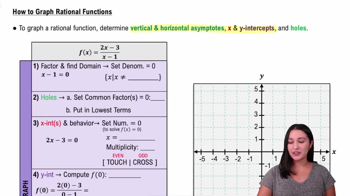Here are the essential concepts you must grasp in order to answer the question correctly.
Asymptotes
Asymptotes are lines that a graph approaches but never touches. Vertical asymptotes occur where a function is undefined, typically where the denominator equals zero. Horizontal asymptotes indicate the behavior of a function as x approaches infinity, while slant (or oblique) asymptotes occur when the degree of the numerator is one higher than that of the denominator, indicating a linear behavior at infinity.
Recommended video:
Introduction to Asymptotes
Rational Functions
A rational function is a function represented by the ratio of two polynomials. The general form is r(x) = P(x)/Q(x), where P and Q are polynomials. Understanding the degrees of the polynomials in the numerator and denominator is crucial for determining the behavior of the function, including the existence and type of asymptotes.
Recommended video:
Intro to Rational Functions
Graphing Rational Functions
Graphing rational functions involves analyzing their asymptotic behavior, intercepts, and overall shape. Key steps include identifying vertical and horizontal asymptotes, finding x- and y-intercepts, and determining the function's end behavior. This comprehensive approach helps in sketching an accurate graph that reflects the function's characteristics.
Recommended video:
How to Graph Rational Functions
 Verified step by step guidance
Verified step by step guidance Verified video answer for a similar problem:
Verified video answer for a similar problem:



 5:31m
5:31m